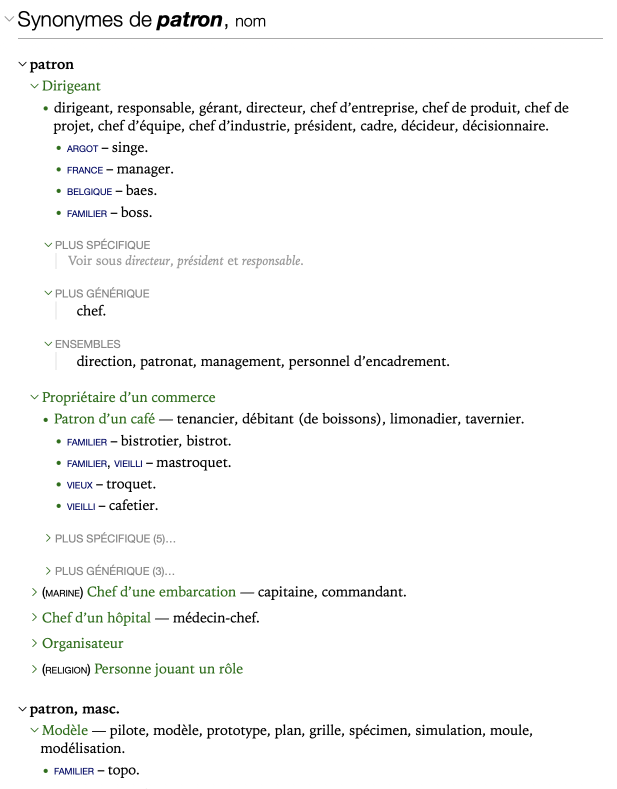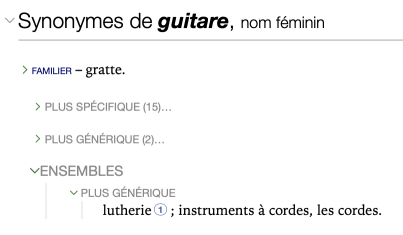Contenu du dictionnaire de synonymes
D’une richesse inépuisable, le dictionnaire de synonymes vous offre un million de synonymes, y compris des expressions comme casser la croute et tenant du titre. Il recense aussi plusieurs dizaines de milliers d’hyponymes et d’hyperonymes.
-
 12345678
12345678
Les sens principaux
Les synonymes sont groupés par sens. Chaque groupe est introduit par un chevron qui module l’affichage des listes de synonymes pour chaque sens. Il alterne entre un affichage exhaustif, pratique pour une recherche approfondie du sens voulu, et un affichage sommaire, plus utile lors d’un survol. Le même symbole situé dans l’entête permet de commander d’un seul clic le dévoilement de toutes les listes. Lorsque la vedette a plus d’un sens possible, une courte étiquette en vert spécifie le sens visé.
Les sous-sens
Chaque sous-sens (nuance de sens ou d’emploi) est indenté sous son sens principal et introduit par un point gras vert (●).
Les hyperonymes et les hyponymes
Les hyperonymes sont des synonymes de sens plus générique que le mot en vedette. Par exemple, le mot voiture a comme synonymes précis automobile, auto, bagnole, etc., mais a comme hyperonyme véhicule, plus général. Les hyperonymes sont introduits par la mention plus générique et sont indentés à droite d’un filet vertical. Un chevron de dévoilement permet de les afficher ou de les masquer (le nombre d’hyperonymes masqués est alors indiqué).
Les hyponymes sont des synonymes de sens plus spécifique que le mot en vedette. Par exemple, voiture a comme hyponymes berline, citadine, coupé, etc., qui sont des types particuliers de voitures. Les hyponymes sont introduits par la mention plus spécifique et sont indentés à droite d’un filet vertical. Un chevron de dévoilement permet de les afficher ou de les masquer (le nombre d’hyponymes masqués est alors indiqué).
Lorsqu’un hyponyme (ou un hyperonyme) affiché possède lui-même des hyponymes, le nombre de ceux-ci est indiqué dans un petit cercle affiché à sa droite. Un clic sur le cercle dévoile la liste complète de ses hyponymes. Le processus peut être récursif si certains de ceux-ci possèdent eux-mêmes des hyponymes. Vous pouvez ainsi naviguer dans la hiérarchie sémantique et trouver facilement le terme précis qui vous échappe, ou encore élargir vos connaissances en explorant les diverses familles sémantiques.
Les ensembles
Certains mots désignent des entités qui, regroupées, forment un ensemble désigné par un nom précis. Par exemple, un regroupement de loups est une meute, un ensemble d’atomes, une molécule. Ces collectifs sont classés sous la bannière ensembles, au même niveau d’indentation que les hyponymes et les hyperonymes. Par leur précision, ces synonymes particuliers contribuent à la richesse lexicale de votre texte.
Les marques
Les marques, en petites capitales, précisent le contexte d’emploi des synonymes qu’elles introduisent. Les marques de domaine, en caractères noirs, servent à indiquer le secteur de l’activité humaine dans lequel le synonyme est employé (ex. : astronomie, musique, droit, etc.). Les marques d’usage, quant à elles, situent le synonyme dans un registre linguistique particulier : niveau de langue, emploi régional, métaphorique, etc. La majorité des marques d’usage sont affichées en bleu (ex. : familier, Belgique, figuré, etc.). Sont toutefois affichées en rouge, pour mieux capter votre attention, les marques d’usage qui introduisent des synonymes dont l’emploi requiert votre plus grande vigilance (mots vulgaires, péjoratifs, offensants, discriminatoires, etc.).
- Pour configurer l’affichage / le non-affichage des synonymes marqués, cliquez sur le bouton à droite de l’entête, puis sélectionnez le comportement désiré à l’option Marqués.
Les contextes

Les contextes, en gris et entre parenthèses, vous mettent en garde contre un choix trop hâtif en précisant une nuance de sens importante du synonyme qui précède.
Le point-virgule

À l’intérieur d’un sens principal ou d’un sous-sens, les synonymes suivent l’ordre alphabétique, sauf dans certaines énumérations d’hyperonymes, où c’est l’ordre hiérarchique qui est préservé. De même, le point-virgule est parfois utilisé dans les énumérations d’hyponymes et d’hyperonymes pour indiquer une frontière sémantique ou pour préserver une hiérarchie.
La barre oblique

La barre oblique sert à relier des hyponymes qui sont synonymes entre eux.
Les grandes sections sémantiques
Les entrées qui possèdent de nombreux sens sont parfois divisées en grandes sections sémantiques, afin de faciliter le repérage. Ainsi, le nom examen comporte deux sections : « observation », « épreuve ».
Les grandes sections morphologiques
Certaines entrées sont aussi séparées en grandes divisions lorsque leurs formes particulières ont des sens distincts. Par exemple, l’entrée de dormeur se divise en trois sections : « dormeur », « dormeur, masc. » et « dormeuse, fém. ».
Des divisions sont également introduites lorsque la forme pronominale d’un verbe a ses propres synonymes, comme c’est le cas du verbe résoudre, qui comporte les sections « résoudre » et « se résoudre ».
Le tri des synonymes
En fonction des besoins, l’on peut trier les synonymes affichés de quatre façons différentes : en ordre alphabétique (tri par défaut), par pertinence, par fréquence ou par longueur (nombre de lettres). On accède à ces options en cliquant sur le bouton à droite de l’entête.
Les filtres
Antidote offre des filtres qui permettent de n’afficher qu’une partie des synonymes. Le premier permet de les filtrer en fonction de leur force sémantique ou expressive (fort, neutre, faible). Le second masque l’affichage des synonymes accompagnés d’une marque d’usage ou de domaine.
- Par défaut, tous les synonymes sont affichés.
- La mention Filtre(s) activé(s) sous le bouton vous informe que des synonymes sont ponctuellement masqués. Cliquez sur pour désactiver les filtres et revenir à l’affichage complet.
Affichage des définitions
Le panneau de droite affiche les définitions des synonymes sélectionnés. En ayant à la fois les synonymes et leur définition sous les yeux, vous pouvez trouver rapidement le synonyme qui vous convient.

- À l’ouverture des synonymes ou après une recherche, les définitions qui s’affichent correspondent au mot en vedette. Déplacez la sélection avec la souris ou les flèches du clavier pour afficher les définitions de chaque synonyme.